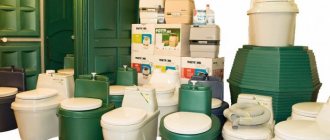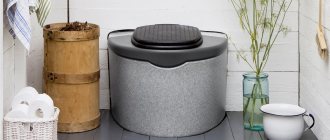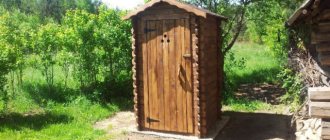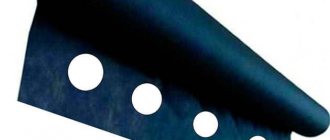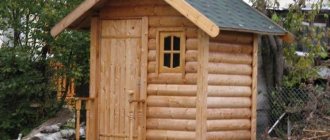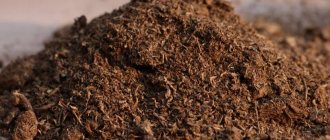A wooden toilet of the “hole in the floor” system is not only cheap, cheerful and indescribably fragrant, but also dangerous for fines. Therefore, it is not surprising that many owners of summer cottages are beginning to consider a dry closet as the main alternative to the usual “houses for privacy.”
Not all settlements, let alone SNT, can boast of having a central sewerage system. Therefore, most often, summer residents install “traditional” toilets on their plots. At the same time, according to SNiP 30-02-97, it is not enough to simply dig a hole in the far corner of the site and put a wooden shed on it.
Firstly, certain sanitary standards must be observed, according to which the toilet should be located at a distance of 12 m from residential buildings, cellars and playgrounds, 8 m from wells and other sources of drinking water, 1 m from the fence.
Secondly, according to the same sanitary standards, in the absence of a central sewerage system, it is permissible to build only certain types of toilets on the site: dry toilet, powder closet (peat toilet), backlash closet (outdoor toilet with an isolated cesspool).
Please note that often, when speaking about dry closets, they mean not only dry closets as such, but also peat powder closets.
Depending on the method of decomposition of biomaterial, dry toilets are divided into three categories: peat, chemical (liquid) and electric.
Choosing a dry closet by type
Based on the method of “processing” waste, there are three types of bio toilets for dachas.
Peat dry toilets
These are direct descendants of powder closets, in which the faeces were covered with peat before being transferred to a holding tank. The organic matter of peat was “responsible” for the primary processing and separation of waste into liquid and “solid” phases. Modern samples, unlike their predecessors, are charged with a mixture enriched with active bacteria, so separation occurs much faster and more efficiently.
The solid phase is disposed of in a compost pit, and after a couple of years they have “pure” organic fertilizer for the site. The liquid phase has a sufficient degree of purification to be discharged into the drainage system. One of the distinguishing features is the presence of a gaseous phase, since the principle of operation of this type of toilet is similar to a septic tank. Therefore, the lower tank is made in the form of a sealed container of a fairly large volume, which has two outlets: drainage and for connection to a separate exhaust ventilation duct.
The sealed storage tank of the peat toilet, taken outside the room, almost completely blocks unpleasant odors
Advantages:
- Simple device. There are models that are completely energy-independent - without an exhaust fan.
- With a large volume of the lower tank, frequent cleaning of solid waste is not required.
- Relatively low cost of reagents.
- "Environmental friendliness" of waste.
Flaws:
- Stationary installation.
- Isolation of a separate exhaust ventilation channel (pipe).
- For models with high “performance”, it is necessary to consider the location and transportation route of the lower tank. There are examples of country dry toilets for installation in a separate building (extension) on a screw or columnar foundation - their storage tank is located in the underground.
- If there is a large influx of visitors, the portion of backfill may not have time to “clean” the liquid (absorb organic matter).
To make it easier to transport a large capacity tank, it is placed on wheels.
Liquid dry toilets
There are two types of liquid reagents that interact with waste:
- Formaldehyde
They stop the processes of biological decomposition, destroy bacteria, whose activity causes the release of foul odors. Although the reagents are the strongest antiseptic and “kill” all living things, they are organic compounds. Therefore, the definition of this liquid toilet as “bio” is quite justified. The main disadvantage is the toxicity of processed products. They must not be disposed of in sewer systems, settling basins, seepage wells or trenches. After filling the storage tank, it is handed over to the company servicing the dry closet for disposal of the contents.
- Amoniaceae
They process “black waste” without access to oxygen, similar to anaerobic septic tanks. With intensive use, feces simply do not have time to reach a state suitable for disposal into a compost pit, but waste products can be disposed of in a regular sewer system.
A liquid toilet will not spoil the air with a bad smell either in the garden or in the house
Advantages:
- hygiene;
- no need for separate forced ventilation;
- They produce cassette or portable toilets for summer cottages, which fit in the trunk of a family-class passenger car.
There are essentially two disadvantages
- limited performance of country models;
- recycling .
Electric biotools
If we consider only ease of use, then this is an ideal option for a non-sewer country toilet. Waste products are simply burned in it (all or only solid ones after waste separation). No flushing water is needed, and the feces and toilet paper in them are completely compostable, so they may be listed as “dry” or “composted” in the catalog.
Advantages:
- ease of waste disposal - can be buried in the ground directly on the site in the form of organic fertilizer;
- no need to purchase reagents;
- long period between tank cleaning.
Flaws:
- high cost;
- the need for a separate ventilation duct for the “combustion chamber”;
- energy dependence.
Candles will add a certain “romantic” note, but without electricity this type of bio-toilet will not work
Dry toilets from Pacto
This is a separate type of “bio” class toilets that are completely autonomous. That is, they do not require connection to the network or water supply.
The principle of operation of the Pacto dry closet is based on the collection of feces and urine in a film (encapsulation). In this case, odors are almost completely blocked along with the contents by simply pressing the “flush” pedal. The delivery set includes a roll of sleeves with a supply of film for approximately 200-250 visits (roll length - 40 m). A one-time refill is designed for 40 visits (taking into account that the pedal can be pressed halfway when flushing urine). The indication that the film has reached the end is simple - the inscription “Stop” is printed on the last section.
Capsules with sealed waste are collected in a separate bag in a special container, which is placed in the underground under the toilet room, or in the Pacto podium. In the first case, ventilation is not necessary. When using a podium, a ventilation pipe is removed from it.
This is what the Pacto toilet looks like on the podium
Encapsulated waste can simply be burned, and the film does not emit toxic gases. And the bag in which the “capsules” were collected is reusable.
The main disadvantage is the high cost of Pacto. It costs on average an order of magnitude higher than a portable liquid one - from 63,000 rubles, and the purchase of a podium increases the cost of a “bio” toilet for a summer residence by another 25,000 rubles.
Peat
There is an opinion that the best dry toilets for summer cottages and gardens are peat ones. And this statement is not without meaning, because the absorbent is exclusively environmentally friendly ingredients - peat and the bacteria living in it.
This means that processed products can be easily sent to the compost heap, and subsequently used as fertilizer. It can be placed both indoors and outdoors, but in the first case ventilation will be required.
pros
- Absolute environmental cleanliness.
- Slow filling of the waste tank.
- Low cost of operation. Despite the fact that special peat is required (usually there is an insufficient content of microorganisms), this does not particularly affect the cost of maintenance, and a peat dry closet is rightfully considered the cheapest to maintain.
- Frosts are not scary, which makes it possible to use it outdoors.
Minuses
- If installed indoors, additional ventilation is required.
- Heavy waste tank, which may cause inconvenience for people with limited mobility.
- For the above reasons, it requires permanent installation.
- Uneven distribution of processing material to waste.
Which dry toilets are better?
From the description of the operating principle, advantages and disadvantages, we can derive recommendations for choosing a dry closet:
- Models operating on peat mixtures are attractive for owners of large plots, where there is a place for a compost pit that will be far enough from the house, recreation area and will not disturb the residents of the neighboring dacha.
- Compact liquid models can satisfy owners of small cottages that are visited infrequently. The main necessary condition is that the cottage must be located near the city and the organization that disposes of the contents of the lower tank.
The advantage of a liquid toilet is that you can buy it already with a stall
- An electric dry closet will bring “joy” to a wealthy dacha owner if there are no power outages in the village.
Installation of toilet cabins
Toilet cabin arrangement
In many public places it is not possible to equip ordinary toilets, and in such cases mobile dry toilets come to the rescue. They have already become indispensable for various public events, are widely used in organizing traveling fairs and folk festivals, and are installed in markets and construction sites.
A stationary outdoor dry closet consists of a base to which three walls and a front panel with a hinged door are attached. The structure has a roof on top.
The walls and all components are made of durable plastic that is resistant to mechanical damage and fire. The material used for the manufacture of dry toilets tolerates temperature changes well, is not destroyed by exposure to sunlight and is resistant to aggressive chemicals. It is not afraid of corrosion, it is easy to clean and does not require regular touch-up.
Watch the video, device:
Inside the cabin there is a toilet equipped with a tight-fitting lid. Underneath there is a storage tank into which waste falls. This tank is particularly durable and resistant to active chemical liquids, which break down all impurities in it. Ventilation is provided inside the cabin, allowing unpleasant odors and harmful fumes to escape outside.
An outdoor mobile dry toilet, which is not a problem to buy today, is additionally equipped with a toilet paper holder, hooks for clothes and bags. Some models are equipped with mirrors, washbasins and liquid soap dispensers. Luxury class cabins may have a heating device used in the cold season.
The small dimensions and light weight of dry closets make them easy to transport and install in a new location. To install the booths, a specially prepared site is not required, but free access to them by special vehicles for cleaning containers must be provided.
Prices for dry toilets
If we arrange dry closets of different types according to increasing prices, then in terms of the level of “capital” investments, liquid models are the most affordable.
Cost of liquid dry toilets
Portable samples with a lower tank volume of 15 to 20 liters generally cost no more than 10,000 rubles. (prices start from 4,500 rubles). Although there are luxury products, for which you will have to pay a little more - for example, Thetford Excellence+ costs from 11,500 rubles.
Manufacturers evaluate dry closets familiar from city streets according to their level of equipment:
- “Economy class” costs from 13,500 rubles. ("Economy class);
- for the “standard” you have to pay 3000 rubles. more;
- “comfort” will cost almost 20,000 rubles;
- “VIP” (with heating and lighting) – about 30,000 rubles.
In fact, the VIP version is a standard set of amenities for the toilet of an ordinary city apartment
Cost of peat dry toilets
With peat dry closets, not everything is clear.
There are Russian-made samples that most summer residents can afford. For example, Piteco 201 costs about 9,000 rubles, and Piteco 505 or Piteco 506 costs 5,500-5,600 rubles. Of course, such products are “flushed” manually, but the capacity of the storage tank is nevertheless impressive - 72 liters.
If we talk about prices for products of foreign brands, they can cost several times higher. For example, the Finnish KEKKILA Termotoilet with a tank volume of 230 liters costs about 40,000 rubles. A “luxury class” sample of BIOLAN Populett 200 is estimated at 65,000 rubles.
And this is only the “visible part” of BIOLAN Populett 200
You can find peat toilets a little cheaper, but in these cases their “performance” will be lower. The same BIOLAN has in its assortment the Komplet model with a lower tank of 140 liters and a price of 22,500 rubles. or a very simple option for 12,500 rubles, which is called “Simplett”, but it already has a volume of 28 liters, and we are talking only about “solid” waste, since liquid waste is separated in the toilet seat area and discharged into its own canister.
Simplett is the “smallest” dry toilet in its family
Cost of electric dry closets
Electric dry closets can be divided into two categories.
The first, more accessible, category includes products with waste separation - liquid waste is discharged with a hose into a tank or into the ground.
The second category of products is the complete recycling of waste products, including toilet paper. First, due to heating, the “excess” liquid evaporates, then the remainder is burned. Moreover, in order for the residue to be homogeneous, it is “grinded” with a mixer equipped with cutting blades (like in a mixer).
The first category includes toilets from Separett (from 18,000 to 55,000 rubles). The second category includes Biolet Mulltoa toilets (from 50,000 to 140,000 rubles).
Note! The difference in price between products from the same manufacturer is explained by the volume of the tank.
This is what the diagram of biotoilets from the Biolet Mulltoa family looks like
Manufacturer
On the modern market, dry toilets are represented by many companies. Some of these companies are considered the best manufacturers of the products in question. The popularity of models from such manufacturers as:
- Bioforce;
- Thetford;
- Sviti;
- Biolan;
- Kekkila;
- Separett;
- Piteco;
- Ecomark;
- EgoGroup.
